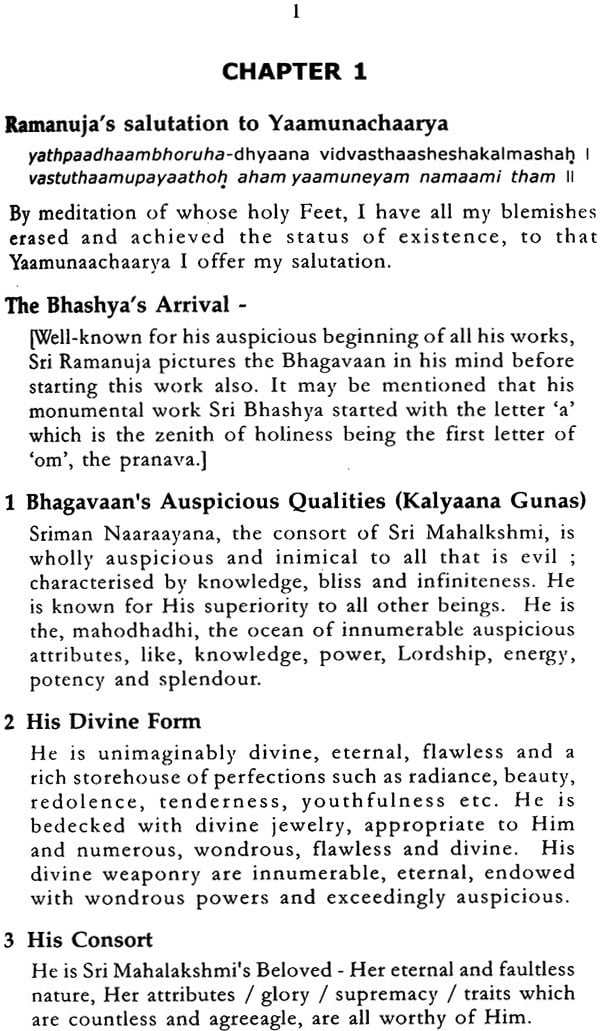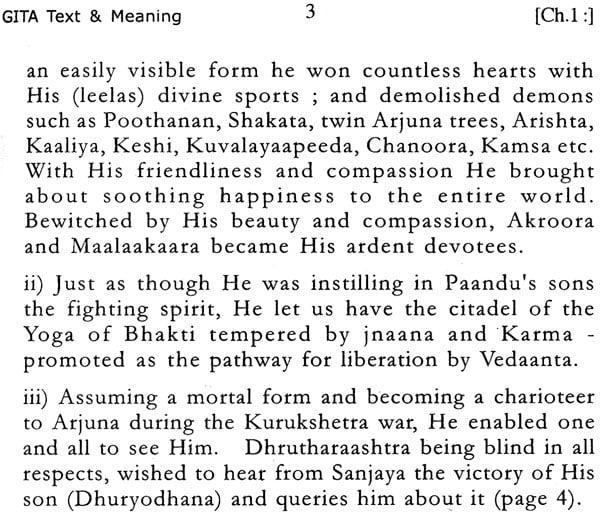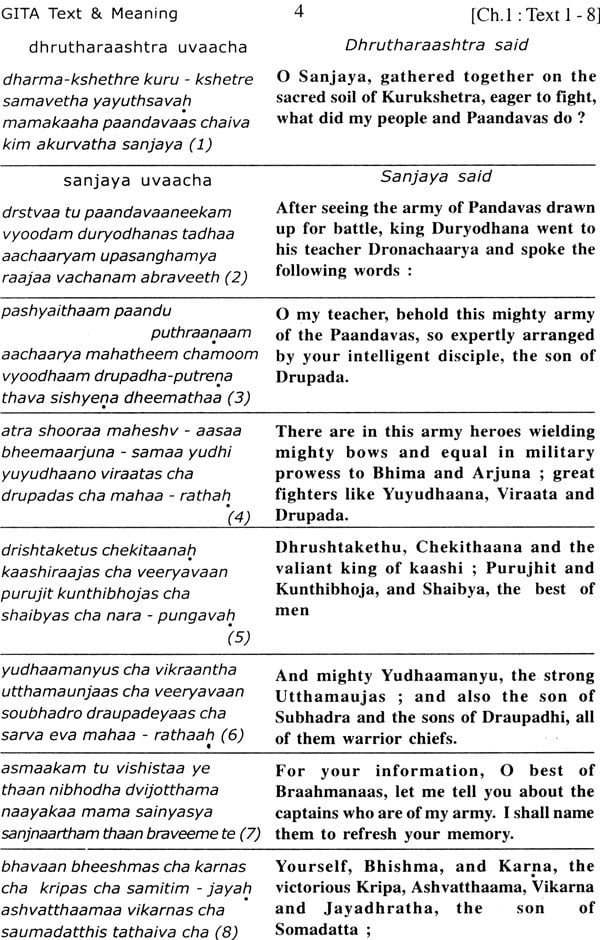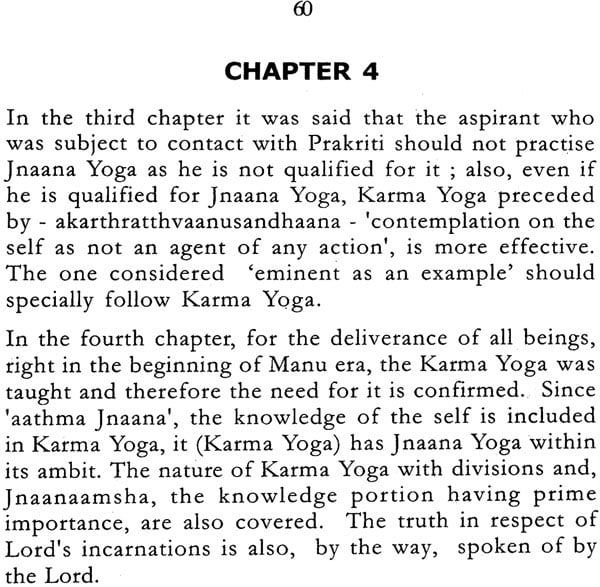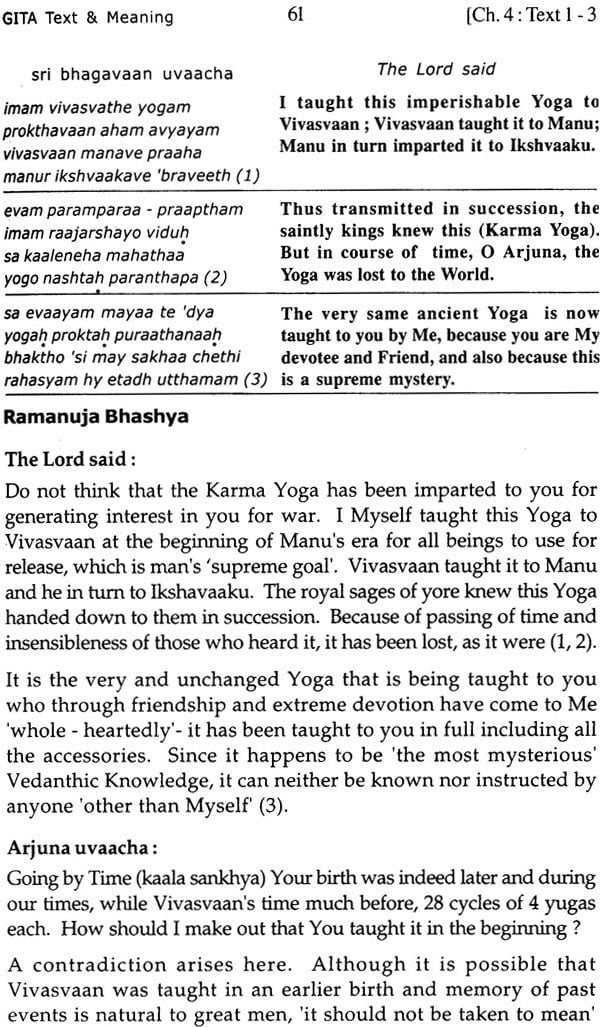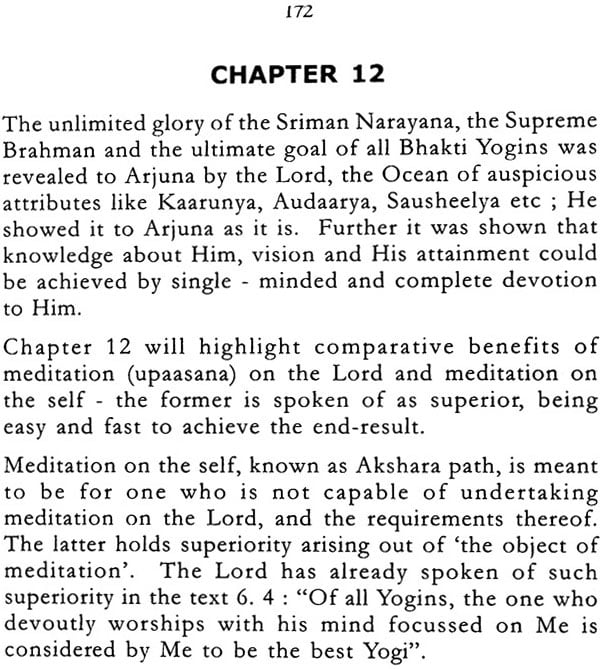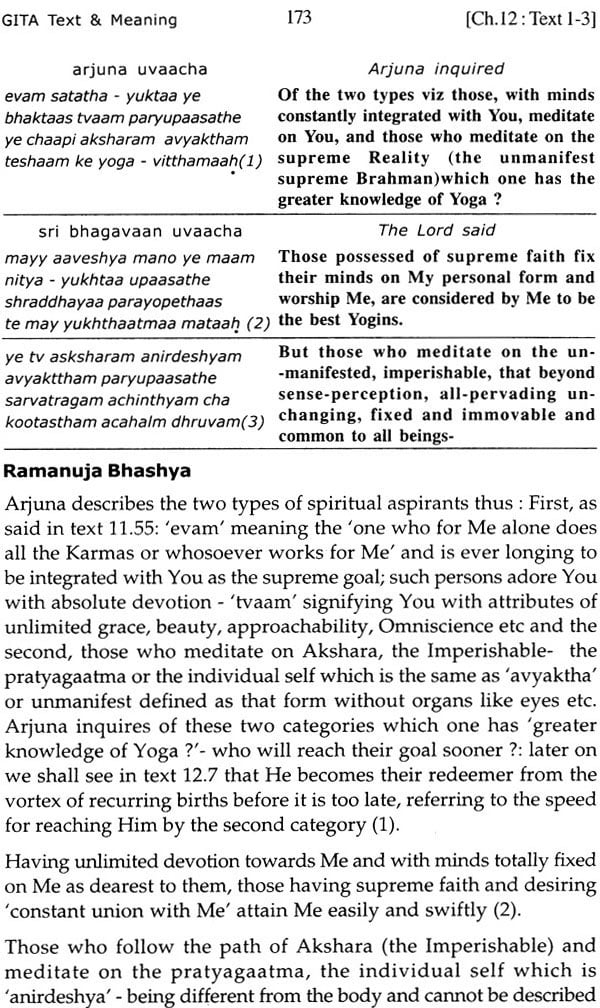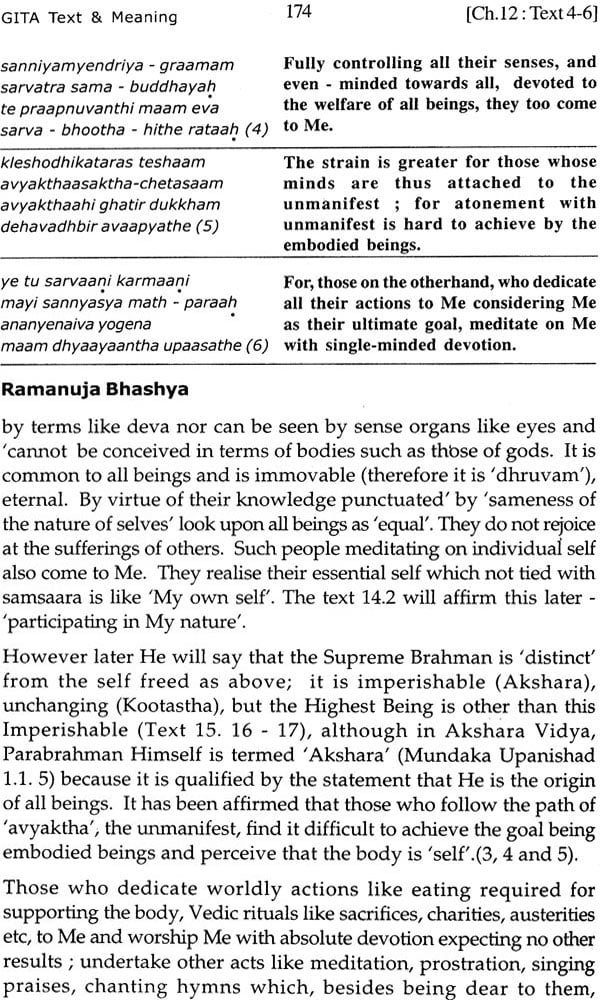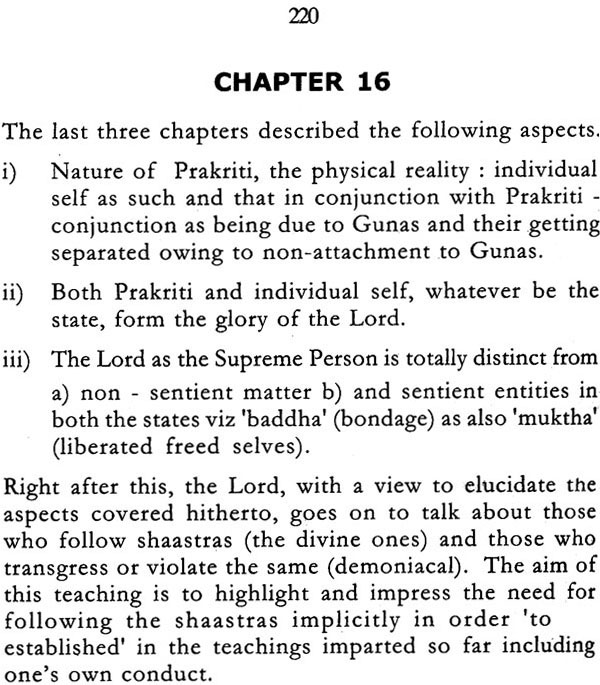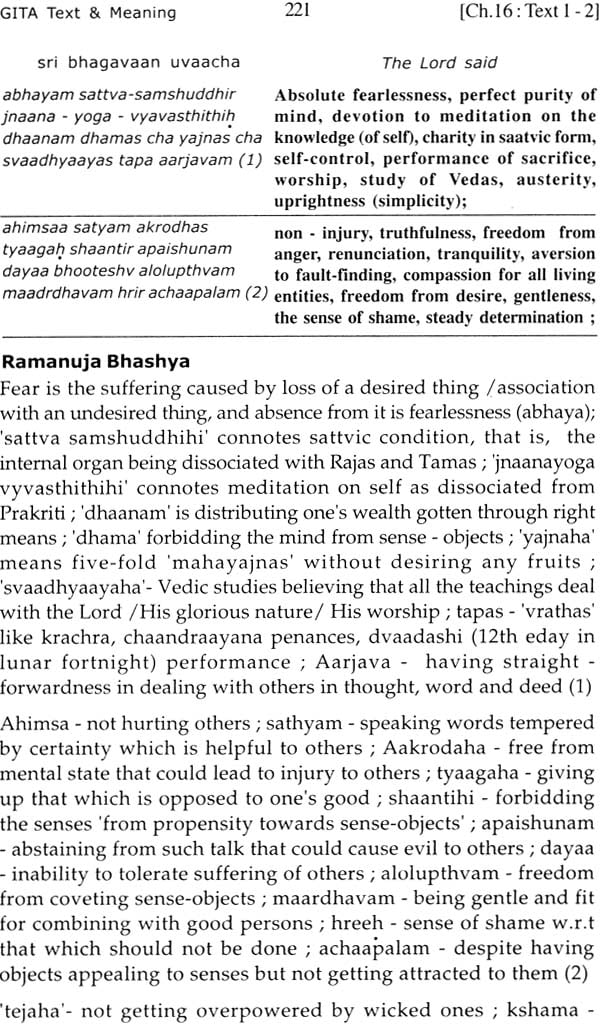
A Condensed Rendering of Sri Ramanuja's Gita Bhashya
Book Specification
| Item Code: | NAM673 |
| Author: | K. R. Krishnaswami |
| Publisher: | A & K PRAKASHANA |
| Language: | Transliteration With English Translation |
| Edition: | 2003 |
| Pages: | 292 |
| Cover: | Paperback |
| Other Details | 8.5 inch X 5.5 inch |
| Weight | 330 gm |
Book Description
This is my seventh publication in the 'subject familiarisation series', and the third and final book in the Prasthaana Traya, the other two being:
1. An Introduction To Brahma Sutras and Sri Ramanuja Sri Bhashya, and
2. An Introduction To Upanishads with a special chapter 'Sri Ramanuja on Upanishads'
"Prasathaana Traya" means the three foundational (or basic) texts on our Vedanta Darshana or spiritual wisdom. The present book 'Sri Ramanuja's Geethaa Bhashya' is as the name suggests, a commentary on the lofty yet easy-looking Sri Bhagavad Geethaa which came down to this earth through the very lips of the Lord, while the Vedas were routed through Chaturmukha Brahma. The Geethaa when read in conjunction with the Bhashya, opens up a vast treasure-house of the Lord's thoughts on diverse subjects and gives us a glimpse of His intense love and compassion for the vast humanity at large.
Rather intriguing that such an important work by Ramanuja has not seen many versions in other languages: does this again point to the proverbial apathy of the Srivaishnavas towards the treasures left behind by their Poorvacharyas ? We should have had dozens of books aimed at 'Prachaaram' of Sri Ramanuja's views on such an important subject, but it is sad that just one hand is enough to take a count of the treatises that have been published say, for e.g., in a language like Kannada.
In my book I have provided the original Geethaa text transliterated into English and alongside each text (sloka), I have given its meaning - the meaning has been arrived at after study of a number of books on Geethaa, a common denominator hopefully reflecting the meaning intended by the Lord! Given below each text with meaning, is the Ramanuja Bhashya foreach in the same serial order.
I want to reassure my readers that all though a close watch was kept on the size of the book, no effort has been spared to retain the content and nuances of the original bhashya. This has been rendered possible by shortening the elaboration but keeping intact the interlinks like quotations from Upanishads, references to slokas in earlier chapters etc., as in the original bhashya. Included are some key sanskrit words and phrases from the originals (Geethaa as also bhashya) for the purpose of highlighting the meanings as in the commentary. I do hope that this effort of a condensed version of Geethaa Bhashya in English will be welcomed and that it will kindle interest amongst young readers to seek and get hold of the original text with full commentary in the language of their choice -sanskrit, Kannada etc.
I am happy to see that the Ramanuja daasas living in the Middle East and the USA are evincing interest in such publications and voluntarily coming forward to sponsor them. It was indeed a pleasant surprise that a young bachelor called me up from nearabout Los Angeles to say that he would like to sponsor whatever book I was writing presently. What more can a writer ask for?
It is my experiences that abridging a classic like Geethaa Bhashya into a size such as this in English language is some effort and I bow to Sri Geethaa Chaarya, the Lord, for bestowing me the necessary confidence and courage to undertake this kainkaryam.
The Lord, Sri Krishna that He is, bequeathed a unique treasure with the sole purpose of providing a panacea for all the ills we are facing in this world. Sri Bhagavad Geethaa is verily 'the factual position of the living entities- man has no doubt specialised in satisfying his material senses, but precious little does he do in fulfilling the simple demands of the Lord to strive for perfection in life. It is not intended here 'to introduce as it were' the Bhagavad Geethaa since most of us would have read about it or heard lectures on it some time or the other. Bhagavad Geethaa appears as an episode in Mahabharatha, Bhishma Parva. Mahabharatha itself is called Panchama Veda preceded by Rik, Yajus, Saama and Atharvan Vedas. The Geethaa by common consent is the noblest of works in the world, 'the greatest philosophical and religious dialogues known to man'. As it often happens in our country, its greatness becomes clearer when foreign scholars (like Schopenhaner, Max Mueller and a host of others) laud and admire it. Thoreau said he bathed his intellect every morning in the Bhagavad Geetha. Emerson expressed ' it was as if an empire spoke to us'.
While Vedas descended from Brahma, the Geethaa has the added holiness of having flowed from the Lord's very lotus-like lips; the holiest poetic symphony as it were, a symphony of diverse Upanishadic messages. In Varaaha Puraana, the Lord says : 'I take my stand on the Geethaa ; the Geetha is My Supreme Abode. I maintain the three worlds on the strength of the wisdom contained in the Geethaa'.
Sri Ramanuja, the acharya that he is, has written bhashyas 'formally' on The Brahma Sutras and Bhagavad Geethaa. In regard to Upanishads his gloss Vedartha Sangraha, and his masterly commentary on Upanishadic texts in Sri Bhashya and Geethaa Bhashya more than, according to scholars, make for a 'formal' bhashya on Upanishads. However The Gita Bhashya is relatively simpler compared to the scholastic treatise on Brahma Sutras viz. Sri Bhashya. On the face of it, the slokas appear to be simple to understand but if they are read along with a Bhashya such as Sri Ramanuja's, the whole gamut of Lord's teachings open up to our amazement and we get the full import of the texts.,
In regard to the language and style of Geethaa Bhashya by Ramanuja it is worth quoting Swami Tapasyananda who observed: "The excellence of the language in which his Bhashya is written deserves special praise . Ramanuja's Sanskrit style which is noted for its melodious sweetness (with) sentences that are music to ear. The apostle of Bhakti that he is, uses the word magic to thrill the hearts of the hearers unfurl (ing) before us a panchromatic banner of adjectives…
Ramanuja confines as usual to the straight-forward interpretation of the text and does not get into any 'polemics', meaning controversies. There are, however, two places in Geethaa Bhashya, where for clarifying and establishing the precise import of the original, he has necessarily and deliberately trodden on what might be termed 'polemic issues'.
Ramanuja is said to have had inspiration from his predecessor Yaamunaachaarya who wrote a small work on Geethaa known as Geetaartha Sangraha - it has 32 slokas. The first sloka itself is so meaningful, that it summarises the entire Geethaa:
“……(in) Bhagavad Geethaa, (Sriman) Naarayana, the Supreme Brahman is declared. He is attained by bhakti alone, bhakti which is the result of one's own Dharma, 'acquisition of knowledge and renunciation of attachment'.
PREPARING ONESELF TO STUDY THE BHASHYA
1 The Scene
THE SCENE is set: The Lord becomes the saarathy for the Mahaarathi, Arjuna, driving 'the fabled bow -man's Chariot'. The two armies, of Paandavas and Kauravas, are arrayed, ready to fight, ready to combat. A close look at the array, Arjuna is distraught at the thought of slaughtering his kith and kin, his acharyas. 'The Geetha, the discourse in poetic style', starts with Lord's exhortation to Arjuna to do his duty. Despite knowing that Krishna, the Lord that He is, was on Paandava's side which meant a certain victory, Dhritharaashtra hopes against hope that his sons will come out victorious and win the war - he anxiously enquires from his 'Man - Friday' Sanjaya : 'What did they do ?' 50 starts the Geethaa.
2 Composition of the Geethaa
Upanishads are at the base of our Vedaantic concepts (Sarvopanishadho gaavah). The Geetha also propounds the Upanishadic meanings in the 700 texts (slokas) divided into 18 chapters - it, however, appears that in the pre-Shankara period there were 745 texts in the Geethaa; the figure of 700 has been accepted by Poorvachaaryas including Shankara, Each chapter has had a title with reference to teaching of the main message.
| 1. | Introduction | viii |
| 2. | Preparing oneself for study of the Bhashya | X |
| 3. | Shatka (Hexad) - Wise Summary of Geethaa Bhashya | |
| First Shatka | xii | |
| Second Shatka | xiii | |
| Third Shatka | xvi | |
| 4. | Geethaa Text, Meaning & Bhashya | |
| First Chapter | 1 | |
| Second Chapter | 12 | |
| Third Chapter | 40 | |
| Fourth Chapter | 60 | |
| Fifth Chapter | 77 | |
| Sixth Chapter | 88 | |
| Seventh Chapter | 104 | |
| Eighth Chapter | 116 | |
| Ninth Chapter | 127 | |
| Tenth Chapter | 139 | |
| Eleventh Chapter | 151 | |
| Twelth Chapter | 172 | |
| Thirteenth Chapter | 180 | |
| Fourteenth Chapter | 199 | |
| Fifteenth Chapter | 210 | |
| Sixteenth Chapter | 220 | |
| Seventeenth Chapter | 229 | |
| Eighteenth Chapter | 239 | |
| 5. | References |
